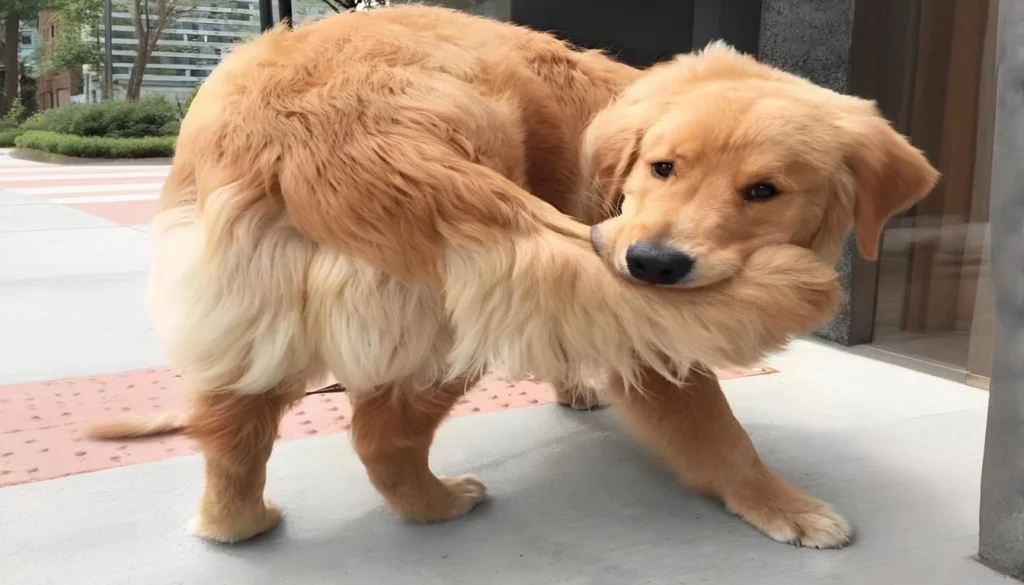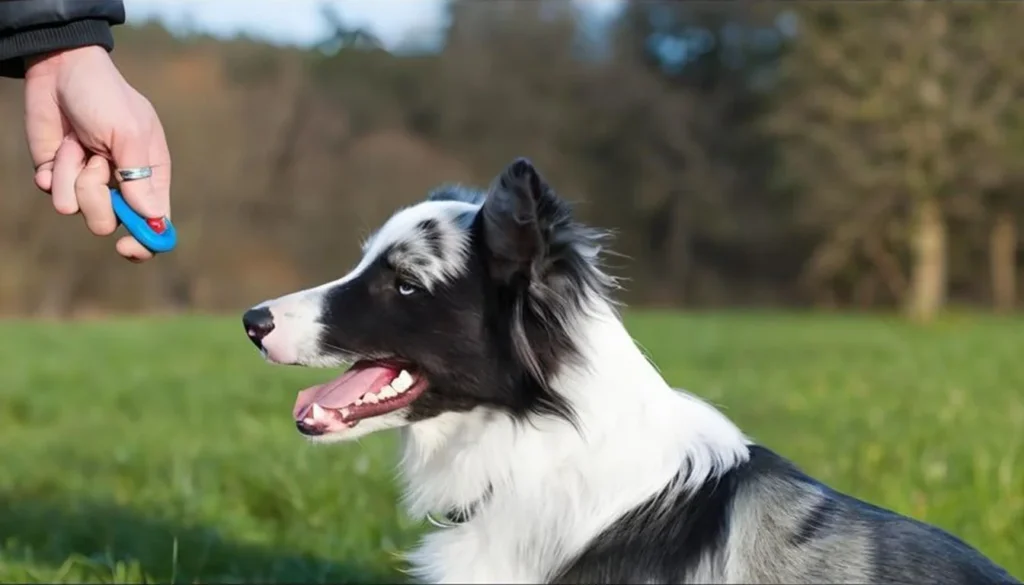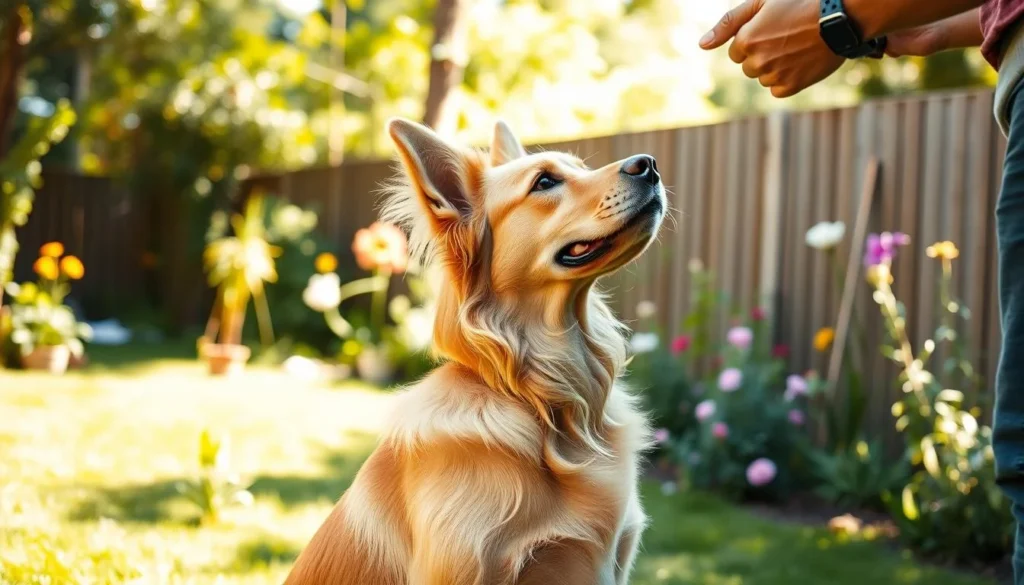Being a dog owner is special. It's filled with joy, laughter, and love. But, it can worry us when our dogs bite their tails. This habit can hurt them and make us sad.
I've looked for ways to stop this. Knowing why dogs bite their tails and finding good solutions helps. We can keep our pets happy and healthy together. Let's find ways to stop our dogs from chewing their tails.
Key Takeaways
- Understanding the reasons behind your dog's tail biting behavior is crucial.
- Identify any physical conditions that may contribute to this habit.
- Recognizing the symptoms early can prevent further issues.
- Both home remedies and training techniques can be effective.
- Creating a calm environment positively impacts your dog's behavior.
- Regular check-ups with a veterinarian are essential for maintaining your dog’s health.
Understanding the Causes of Dog Tail Biting
When a dog bites their tail, it's important to find out why. Knowing why dogs bite their tails helps us understand their behavior. There are many reasons, including their feelings and physical health.
Psychological Factors Leading to Tail Biting
Dogs bite their tails for emotional reasons like anxiety, boredom, or stress. They feel emotions deeply, which affects how they act. Some common reasons include:
- Separation anxiety: Dogs may bite their tails when they're left alone.
- Stress or fear: Loud noises or big changes can upset them.
- Lack of stimulation: Bored dogs might bite their tails for something to do.
Physical Conditions Promoting Tail Biting
Physical problems can also make dogs bite their tails. Issues like allergies or skin infections can be very uncomfortable. Here are a few examples:
- Fleas or ticks: These pests can make a dog's skin itch and scratch.
- Infections: Bacterial or fungal infections can make a dog feel itchy.
- Allergies: Food or environmental allergies can cause inflammation and itching.
By understanding these reasons, we can help dogs stop biting their tails. Knowing what drives this behavior is the first step to helping them.
Identifying Symptoms of Tail Biting in Dogs
It's important to spot the signs of tail biting in dogs early. This can stop problems before they get worse. Here, I'll talk about the signs and behavior changes that show your dog might be biting its tail.
Visible Signs of Tail Biting
I watch for clear signs of tail biting in my dog. Some signs include:
- Redness or irritation around the tail area
- Excessive licking or chewing of the tail
- Loss of fur or bald patches on the tail
- Bleeding or open sores from constant biting
If I see these signs, I know it's time to act fast. Ignoring them could harm my dog's health.
Behavioral Changes Indicating Tail Biting
I also watch my puppy's behavior for signs of trouble. Changes like these might mean my puppy is biting its tail:
- Increased anxiety or restlessness
- Frequent growling or whining near the tail
- Sudden aggression towards other pets, like a dog biting a cat
- Withdrawal from play or social activities
Seeing these changes helps me know when to see a vet or a behavior expert. Early action can help my puppy stay healthy and happy.

Why Do Dogs Bite Their Tail?
Understanding why dogs bite their tail is key for pet owners. Physical discomfort is a common reason. Allergies or skin irritations can make a dog itch and bite its tail.
Emotional stress also affects dogs. They might bite their fur due to anxiety or boredom. Knowing if emotional issues are at play helps me help my dog.
Dogs use their behaviors to communicate. Biting can mean they're uncomfortable, frustrated, or need attention. By watching these signs, I can figure out what my dog needs and act on it.
Home Remedies to Prevent Tail Biting
Dealing with a dog that bites its tail can start with home remedies. Before going to the vet, I tried natural ways to help. Natural oils and homemade sprays are two good options.
Natural Oils and Their Benefits
Natural oils are good for my pet's care. They often calm dogs down. Here are some oils that help:
- Lavender Oil: It's soothing and can relax my dog.
- Tea Tree Oil: It's good for cuts but I dilute it to avoid skin problems.
- Chamomile Oil: It's gentle and helps my dog stay calm.
Homemade Sprays to Deter Biting
Homemade sprays can also stop my dog from biting its tail. I mix safe ingredients to make them. Here are two easy recipes:
| Recipe | Ingredients | Instructions |
|---|---|---|
| Vinegar Spray | 1 part vinegar, 1 part water | Mix in a spray bottle and lightly spritz the tail area. |
| Citrus Spray | 1 cup water, the zest of 1 lemon | Boil the mixture, let it cool, strain, and place in a spray bottle. |

These home remedies and spray recipes help before vet visits. Using natural oils and sprays keeps my dog happy and healthy.
Training Techniques to Stop Tail Biting
Dealing with a dog that chews its tail requires effective training. Positive reinforcement and distraction are key. These methods not only solve the problem but also strengthen our bond.
Positive Reinforcement Strategies
Positive reinforcement rewards good behavior, not bad. When my dog doesn't chew its tail, I give treats, praise, or playtime. This encourages the right behavior. The main points are:
- Immediate rewards after positive behavior.
- Consistent timing to help the dog associate the reward with good behavior.
- Gradual reduction of treats as the behavior improves, focusing on verbal praise.
Distraction and Diversion Methods
Distraction is another useful technique. When my dog starts chewing its tail, I distract it with a toy or a game. Good distraction methods include:
- Interactive toys that keep my dog's mind occupied.
- Frequent walks to engage both physically and mentally.
- Training sessions that teach new tricks, maintaining focus away from the tail.
How to Stop Dog from Chewing Tail
When my puppy keeps biting himself, it worries me. Finding out why he does this is key to fixing it. First, I check if any health issues might be causing the problem. A vet visit can uncover allergies, skin problems, or parasites that hurt him.
After fixing any health problems, I start on behavior changes. I make a daily plan for my dog. Dogs like knowing what's next. A regular schedule for meals, play, and rest helps a lot.
Interactive toys and games are great for keeping him busy. This stops boredom and tail chewing. When he bites his tail, I quickly give him a toy instead. I praise and reward him for playing with the toy, not his tail.
Keeping my dog in a quiet place helps too. It's easier for him to relax without distractions. A medical collar might also help stop the biting. But, it's also important to let him play and rest. This keeps him happy and healthy.
Recognizing Severe Tail Biting Cases
When I see my dog biting her tail a lot, I wonder why. This behavior can lead to serious injuries or bleeding. It's important to know the signs of these severe cases for my dog's health.
If my dog is chewing her tail too much, I check her tail for injuries. Seeing blood or open sores means it's a severe case. I need to take her to the vet right away to avoid infections and other health problems.
At the vet, they will check the injury thoroughly. They'll then create a treatment plan for the injury and the reason behind the biting. It's key to act fast to protect my dog and keep her safe.
Choosing the Right Veterinarian or Dog Behaviorist
When my dog started biting his tail, I knew I had to find the right help. A vet can check for health problems that might cause this. It's important to choose someone who knows about dog behavior.
A dog behaviorist is great for fixing bad behaviors like tail chewing. They make plans that fit each dog's needs. I looked for someone who uses positive methods, making sure my dog feels safe and loved.
Working together, a vet and a dog behaviorist can really help. Talking to both experts made me feel sure we could solve the problem.

| Criteria | Veterinarian | Dog Behaviorist |
|---|---|---|
| Focus | Physical health and medical issues | Behavior modification and training |
| Typical Services | Check-ups, vaccinations, diagnostics | Training sessions, behavior assessments |
| Approach | Medical treatment | Behavioral strategies, emotional support |
| Ideal For | Addressing health-related causes of tail biting | Managing and changing tail-biting behaviors |
Creating a Calming Environment for Your Dog
Creating a calm space for dogs is key to their happiness. Dogs may chew their tails when they're stressed or anxious. When my dog won't stop chewing his tail, I think about his environment. A safe spot for him can really help.
To make a calm space, consider these things:
- Comfortable Bedding: A soft bed or blanket makes them feel secure.
- Calming Scents: Safe essential oils, like lavender, can calm them down.
- Gentle Sounds: Soft music or white noise machines can also calm anxious dogs.
Adding these elements to your dog's area can lower their anxiety. This might also cut down on tail chewing. Always watch your dog's behavior and adjust their space as needed to keep them calm and joyful.
Increasing Mental Stimulation for Your Dog
As a dog owner, I know how vital increasing mental stimulation for dogs is. Engaging my furry friend in mental activities helps reduce bad behaviors like puppy biting tail. It keeps their energy positive.
Adding various activities to my dog’s day keeps boredom away. Puzzle toys are great for their minds. They need to solve problems to get treats. Longer walks also keep them engaged, as they explore and smell new things.
Interactive playtime is another key to keeping my dog’s mind sharp. Games like hide-and-seek or fetch are fun. They make my dog think and strategize. Using different toys and changing the routine keeps things exciting.
The following table summarizes some effective activities for increasing mental stimulation:
| Activity | Description | Benefits |
|---|---|---|
| Puzzle Toys | Toys that require problem-solving to access treats. | Enhances problem-solving skills and keeps dogs occupied. |
| Long Walks | Exploring neighborhoods and parks. | Stimulates senses and provides physical exercise. |
| Interactive Games | Games like fetch or hide-and-seek. | Promotes bonding and mental engagement. |
| Training Sessions | Teaching new commands or tricks. | Improves obedience and mental sharpness. |
Engaging my dog mentally not only stops bad behaviors but also strengthens our bond. Regular mental challenges make us both happier and healthier.
Nurturing Your Dog’s Physical Health
Keeping my dog physically healthy is key to stopping unwanted behaviors like tail biting. Taking a proactive approach to their veterinary care is crucial for their well-being.
Regular Veterinary Check-Ups
Regular vet visits are vital for catching problems early. These visits help the vet check my dog's health and give them the shots they need. Proper care for dog biting includes checking for health issues that might cause stress or discomfort, leading to tail chewing. Following the vet's advice keeps my dog happy and healthy.
Proper Grooming and Nutrition
Adding proper grooming to my routine helps keep my dog's skin and coat healthy. Regular brushing prevents matting and skin irritations that might cause biting. Also, a balanced diet supports their health and can help with allergies or discomfort. A well-fed dog is less likely to chew on their tail.
| Health Aspect | Importance | Actions to Take |
|---|---|---|
| Regular Vet Visits | Preventive care and early detection | Schedule annual check-ups, vaccinations |
| Nutrition | Affects overall health | Provide balanced diet, consult on food allergies |
| Grooming | Maintains skin and coat health | Brush regularly, use quality grooming products |
Using Natural Remedies and Calming Aids
Looking for ways to stop tail biting can lead to natural remedies and calming aids. These options can calm irritated skin and lower anxiety. This makes a better environment for my dog. Here are some natural products to think about.
Topical CBD Balm for Irritated Skin
Topical CBD balms can really help dogs with skin irritation. They use natural ingredients to fight inflammation and pain. Brands like Charlotte's Web have shown these balms soothe skin and help dogs relax.
Herbal Remedies and Supplements
Adding herbal remedies to a dog's care can boost their calmness and health. Supplements with chamomile, valerian root, or passionflower can lower stress and stop tail biting. These calming aids can make my dog's life calmer and less anxious.
Conclusion
Dog tail-biting is a complex issue that can harm my furry friend's well-being. Knowing the causes helps me find ways to stop it. By watching for changes and signs of distress, I can act early.
Using home remedies, positive training, and a calm space helps a lot. It's key to stop my dog from chewing its tail. The path ahead might be tough, but with time, love, and effort, my dog can get better.
Talking to a vet or behaviorist is also important. They offer specific advice and solutions. This way, I can help my dog stay healthy and happy, making our life together better.




